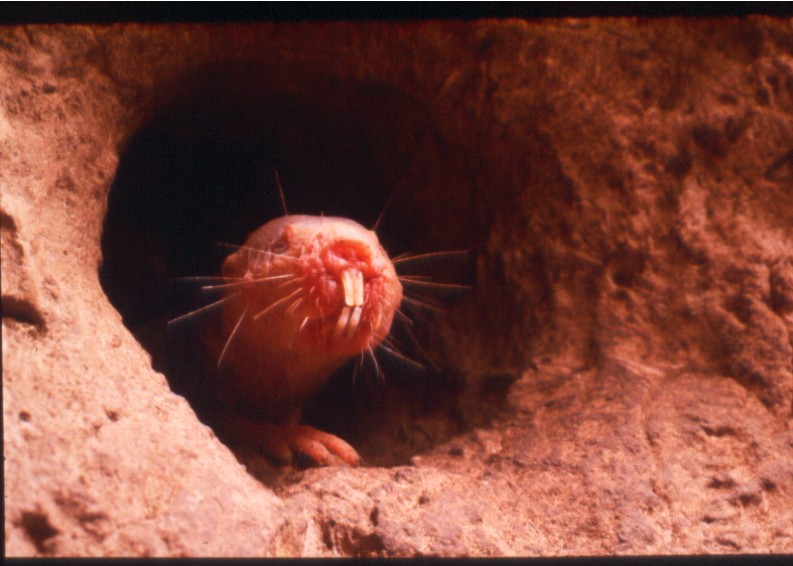Vision
Vision is used both the identify objects in the environment, as well as detect light levels to help regulate the circadian rhythm. Naked Mole Rats have an irregularly structured retina compared to most sighted mammals, resulting in less precise depth perception, and less precise coverage of the lateral regions of the retina. However, beyond these areas, the circuits required for circadian entrainment are preserved.1
Light detection seems mostly to be related to breeding behavior, allowing the female to know when to leave the nest. It could also be useful in an escape response due to a tunnel breech. 2
Touch
Naked mole-rats are not actually naked, but they are very close to it. They have about 40 hairs on each side of their body (tactile hairs which are similar to facial vibrissae) that they use to orient themselves in their subterranean environment. They are organized into a grid-like pattern, and deflection of a single hair results in the mole-rat physically orienting itself towards the stimulus. This orientation is highly accurate, more so than when the skin itself is touched. The orientation also takes into effect where the deflected hair lies on the mole-rat's body, helping the animal to effectively orient itself.3
 |
| Source: http://138.37.56.212/~raycrundwell/Photos/Biological%20and%20Chemical%20Sciences/Mock%20up%20foyer/nakedMoleRat.jpg |
Olfaction
Mole rats use odor cues to distinguish between individuals from their own colony and strangers. Each individual colony has its own scent that is shared and learned by all members. Even closely related colonies have unique scents, attained by mixing of the scents. This way of distinguishing between one's own colony and the neighbors is important due to the high density of colonies in some areas. It is necessary to maintain autonomy in the colony, and to prevent foreign competitors from participating in reproductive succession 4
Degenerative hearing.
Like most subterranean mammals, mole rats have lost much of their ability to localize sounds. Their maximum sensitivity is 35 dB (sound pressure) and their hearing range is only from 65Hz down to 12.8 Hz, meaning that they have lost the ability to hear high-frequency sounds. Also, they cannot localize sounds that are shorter than 400ms. While these results are normal for subterranean animals, it is surprising in naked mole rats given their social structure. They possess a large repertoire of vocalizations, assumed to be for communication, yet their hearing is fairly degenerated, specialized mainly for low frequency sounds. What effect this has on communication is unknown for now.5
Footnotes
1. Mills et. al., 2004.2. Hetling, 2005
3. Crish et. al., 2003.
4. O'Riain, 1997
5. Heffner and Heffner, 1993.